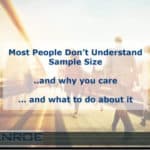When examining any type of customer feedback, one issue that you will come up against is that the feedback people give is not like the feedback you get from a thermometer.
If you want to know what the temperature is, you need only consult a thermometer of the correct type and it will tell you that information to any level of accuracy required. However, the feedback you receive from customers is not quite so neat and tidy.
Ask a customer to provide feedback on a particular touch-point and you are likely to also get information on other areas of the business. You will also get halo affects and other human based biases. They will miss key areas, include unrelated items, score you based on one bad experience three years ago and ignore perfect performance since, etc. In short the data that you receive will be messy.
But that doesn’t make it useless
Clients will often cite the lack of accurate data as the reason that implementation can’t progress or that a decision cannot be made. Messy customer feedback is a prime target for this excuse.
Unfortunately people often overestimate how accurate data needs to be in order to make a decision. This is because there is a prevailing attitude that data must be very accurate in order to be useful. This is simple not true.
Let me provide a quick thought experiment to prove my point. Imagine for a few seconds that you are standing on the side of a road. Just as you step out to cross, from the corner of your eye you perceive something moving towards you. You look quickly, see that it is a car, and jump back to the kerb. Safe.
If I saw this happen and asked, “Before you jumped back did you calculate how heavy the car was, check how many passengers were in the car, determine the make, model and speed?”, you would look at me as if I was mad. It was a car and moving towards you so you jumped out of the way: end of story. But without a highly accurate set of data how could you decide whether or not to jump back?
Patiently absurd, yet this is how many organizations go about the decision making process. Very often, before people are comfortable making a decision, far too much accuracy is demanded in the information inputs. In my example you only needed two pieces of low fidelity information to make a decision: the object was likely to be heavy and coming towards you, the rest was superfluous to the decision.
Data can be messy but also useful
This whole area of how accurate information needs to be is covered in greater detail in an excellent book: “How to measure anything” by Douglas Hubbard. Much of this book is dedicated to helping companies, and people, to determine how accurate information has to be before a decision can be made. Critically it looks at the idea of the value of increased accuracy and how to trade that off against the cost of obtaining that accuracy.
If the value of increasing the accuracy is less than the cost of obtaining that information then you should not expend energy in collecting the data. In our thought experiment above: the value (“how badly am I likely to be hurt if I don’t jump now”) was much lower that the cost (“I am going to be hurt if I don’t jump now”) so you don’t bother to collect any more accuracy.
I highly recommend this book to anyone who has to make or recommend decisions based on data, i.e. everyone in business. After reading it you will never look at data accuracy and the need to be “really sure” the same way again.
Back to our customers
So the data that you will receive from your customer feedback process may be messy and somewhat inconsistent and generally not perfect. That’s because people are messy, somewhat inconsistent and generally not perfect. However, that data can and will be better that no feedback at all and used correctly will be the basis for solid decision-making.












